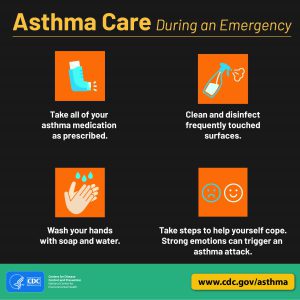Manage Your Asthma During Disasters
Posted on by
*Note: This vignette is a fictional account showing the risks people with asthma might face during an emergency.
Carla* has asthma. To help her manage her asthma, she worked with her doctor to develop an Asthma Action Plan. The plan details the steps Carla needs to take to keep her asthma from getting worse. She also carries her medication everywhere she goes in case she has an asthma attack. Mold is one of her asthma triggers, so she often checks to make sure there are no water leaks or mold in her home.
Even though Carla is used to managing her asthma, she wasn’t prepared when a hurricane reached her coastal town. Carla evacuated her home as instructed by local officials. Her asthma medication was contaminated in floodwater, and she did not have a safely stored backup supply. Her pharmacy had been damaged in the storm and she needed to find a place to replace her medication and supplies.
Carla got sick with the flu, which irritated her airways and made her asthma symptoms worse. When she arrived home, she also found that water had soaked her furniture, allowing mold to grow in several rooms. Afterwards, Carla reflected on her experience and knew she could have prepared better.
People who live with asthma, like Carla, face additional risks during disasters. Extreme events such as hurricanes and wildfires could increase asthma triggers, damage medications, and cause asthma attacks. These risks are present even after a disaster ends.
It’s important to know how you can manage these risks, especially during hurricane season. Take some time to learn how to control your asthma before, during, and after a disaster.

Before Disasters
- Have an Asthma Action Plan: Develop an Asthma Action Plan with your doctor. The plan will help you prevent and control asthma attacks, and it will tell you when you need to use prescribed medication. Continue to follow your Asthma Action Plan before, during, and after a disaster.
- Stock up on supplies: Have at least a 7-10 day supply of your asthma medication. Also keep copies of important documents, such as your insurance card, prescriptions, Asthma Action Plan, and doctor’s contact information.
- Get a flu shot: People with asthma are at higher risk of having serious health problems if they get a respiratory infection, like the flu. Follow CDC guidance for getting a flu shot every year.
During Disasters
- Avoid your asthma triggers: Disasters are associated with several asthma triggers. For example, high winds during disasters could spread dust and pollen. Water could also enter buildings during floods and hurricanes, which could increase the risk of mold growth and trigger an asthma attack. People with asthma should be aware of their asthma triggers and avoid them when possible.
- Keep your hands clean: Follow CDC’s guidelines to wash your hands. This can reduce the spread of germs and lower the risk of becoming infected with an illness that further inflames your airways and lungs.
- Inspect your asthma medication: If your medications are exposed to unsafe water during disasters, they could become contaminated. Follow the FDA’s guidelines for safe drug use after a natural disaster. If you don’t have insurance, you may be able to get help with prescription drugs or medical supplies through the Emergency Prescription Assistance Program.
After Disasters
- Plan for mold cleanup in your home: People with asthma should try to avoid moldy sites and mold clean-up. The home must be dry before cleanup begins. Read the Homeowner’s and Renter’s Guide to Mold Cleanup After Disasters to learn more about safely cleaning up mold and dealing with water damage to building furnishings, furniture, and other belongings. The document provides information about protective clothing and equipment, cleaning supplies, and health effects of mold exposure.
- Disinfect surfaces: Anything that has come in contact with floodwater could carry germs. Cleaning surfaces and household items after a disaster might result in use of some types of disinfectants that can trigger asthma. If possible, ask someone without asthma to disinfect your home. All surfaces need to be cleaned, including tables, doorknobs, light switches, handles, and phones. When cleaning, keep windows open for ventilation and apply disinfectant to a cloth or towel rather than spraying it.
- Take care of your mental health: Stress can trigger an asthma attack. Follow CDC’s guidance to cope with the strong emotions you might feel after a disaster or traumatic event.
If you or a loved one has asthma, prepare for emergencies. Remember to have enough medication and other supplies to manage your condition, avoid your asthma triggers whenever possible, and become familiar with helpful tools including resources to cope with stress. This will help you be better prepared to manage asthma when disaster strikes.
Additional Resources:
- Asthma care during an emergency
- Asthma care before, during, and after a hurricane or other tropical storm
- Information for clinicians helping patients with asthma after a hurricane
- Flooding and mold activity book
Tweet this: “Did you know people with #asthma face additional risks during emergencies like hurricanes or floods? Prepare now by reading the latest #CDCEHblog: https://bit.ly/3BDoDvO via @CDCEnvironment”
A graphic titled “Asthma Care During an Emergency.”
There are four illustrations with accompanying text. The first illustration shows an inhaler with text that says, “Take all of your asthma medication as prescribed.” The second illustration shows hands under running water with text that says, “Wash your hands with soap and water.” The third illustration shows a spray bottle with cleaning solution and text that says, “Clean and disinfect frequently touched surfaces.” The fourth illustration shows a smiling face and a frowning face with text that says, “Take steps to help yourself cope. Strong emotions can trigger an asthma attack.”
Post a Comment